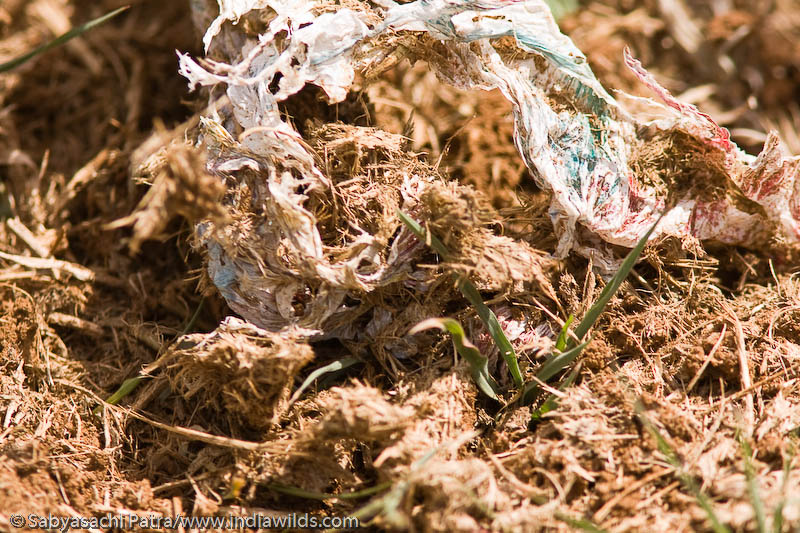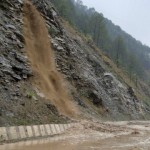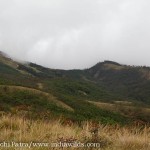IndiaWilds Newsletter Vol. 6 Issue II
Harmful effects of human waste:
Religion has got a great influence on our civilisation.Our code of conduct, values, beliefs, practices and day-to-day activities have been shaped accordingly. So it becomes difficult to imagine that some activities associated with our religion can have deleterious impact on the environment.
Sabrimala attracts an estimated 3 crore pilgrims every year. The heavy rush of pilgrims results in phenomenal amount of littering in the place.
In Valiyaanavattom forest near the famous Sabrimala pilgrimage a 40 year old cow elephant was found dead. During post-mortem it was found that the cow elephant had foraging on the litter strewn path followed by the pilgrims had consumed polythene bags, aluminium foils wrapped with food etc. About two kilograms of polythene bags, aluminium foils, wrappers etc. were found from the stomach of the elephant. The elephant had died due to its stomach getting choked by the plastic and other garbage.
The elephants are fastidious eaters and take great care to remove dirt from the grasses before feeding. However for certain edible items like coconut they swallow it completely and its digestive juices dissolve and absorb the coconut and the outer hard casing comes out undigested with the excreta. So when they find aluminium foil wrapped food, they tend to swallow it. Herbivores also munch these polythene bags or wafer packets because of the salt content in our food. Smaller herbivores like deers are easily killed when they swallow a much smaller amount of polythene bags or wafer packets.
A large mammal like an elephant can with some difficulty throw out the undigested polythene along with its excreta as can be seen in this photograph, which was clicked in Mudumalai Tiger Reserve. I had noticed traces of blood along with the excreta. However, when the number littering increases due to increased number of pilgrims and tourists in the forests, the number of polythene bags swallowed increases and it leads to fatalities.
The devotees of Lord Aiyappa, are expected to practice a tough 41 day long period of penance before undertaking the pilgrimage to Sabrimala. Lord Aiyappa is believed to mount a tiger. So it is really sad to see that the action of his devotees is harming wildlife.
However, the religious practices prescribed for the Sabrimala pilgrims are meant to reduce the impact on environment. The devotees are expected to consume simple vegetarian meal once a day, which is devoid of salt, onions and garlic for 41 days. They are even forbidden from using oil on their head and body. Fruits are to be taken in-lieu of the second meal. The devotees also abstain from alcohol, smoking, chewing pan, oil bath etc. These simple meals over the period of 41 days prior to the pilgrimage not only cleanses the body but also reduces the pollution of the wilderness areas as the human excreta will have less of toxic residues.
Over the years these religious practices have become diluted and have got modified to suit the tastes as well as the convenience of our modern lifestyle.
The bile generated in the body helps in absorbing and digesting the fat and fat-soluble vitamins. When pilgrims continue to eat simple food and fruits the amount of bile salts, bilirubin, cholesterol, phospholipids etc. change in the human excreta making it easier to disintegrate in the nature. The composition of bacteria present in the human excreta also changes due to such a prolonged dietary regime. The colour and smell of the human excreta also changes due to less bile salts and absence of other chemicals. Since the total number of pilgrims in earlier days was low due to the overall smaller population, lack of good roads and conveyance facilities, and fear of wild animals, this environment friendly dietary routine of the pilgrims helped in reducing the impact on the fragile ecosystem of this wilderness area.
Unfortunately, with the huge explosion in the number of people visiting Sabrimala, lack of adherence to the prescribed diets, rampant littering the overall impact on the environment has become grave. Whereas the impact of plastics and non-biodegradable material is easy to understand, the impact of human excreta from pilgrims and the resultant contamination of the fresh water sources in and around the area needs our attention.
This antibiotic resistance is likely to get transferred through the food web as the birds, animals and insect species are going to be predated upon by various predators. In Africa, antibiotics are freely sold over the counter, as is also the case in India. Hence, the chances of our wildlife developing resistance to antibiotics is pretty high.
The human faeces also have a deleterious impact on the health of people. The E. coli bacteria in our excreta contaminate the rivers and streams and anyone consuming those waters are going to suffer. In India, every year about 5 lakh (half a million) children die of diarrhoea. One in every thousand people die of viral hepatitis. So a small act of defecating in the open has such a catastrophic impact on humans as well as on wildlife.
In America, a lot of attention is given to treatment of human excreta of tourists visiting their wild lands. The tour operators strictly monitor it and help in treating it with chemicals and bringing it back for disposal. Unfortunately, in India, anything practices related to any religion is considered sacrosanct and no effort is undertaken to ensure that the environmental impact is minimised.
In various religious events around the country pilgrims and tourists used to be inoculated to prevent the spread of contagious diseases. In some other places like Amarnath Yatra, the tourism and pilgrim traffic is regulated. In some places the local Government authorities are known to have set up temporary shelters and toilet facilities. However, the number of toilet facilities is inadequate to cater to such a huge population. Hence people find defecating in the bush more hygienic than the overused toilet facilities.
An added challenge is that the decomposition of human excreta is also weather, soil and altitude dependent. If the temperature is low, the soil is acidic and anaerobic, then the rate of decomposition of faeces is slow (Liddle 1997).The rains also reduces the decomposition and the water is likely to wash it away and pollute the streams and rivers.
Scavengers like Wild boars are prone to digging and can reach the human faeces if those are not buried atleast under depths of one and half feet. So unless bio-toilets are introduced along the pilgrim routes, all the human excreta should atleast be buried deep.
With over three crore (30 million) people visiting annually, the total digging is also going to be huge. The human faeces are also rich in nutrients and may promote growth of specific vegetation types and its specific local impact needs to be studied.
Most of our rivers like Ganga, Yamuna, Cauvery etc have been polluted and the water is not fit for consumption according to the pollution control board norms. It is time that authorities wake up to the impact of human excreta and ensure that such waste in our wilderness areas are adequately disposed so that there is no contamination of our water resources.
Several State Governments have made some efforts through various schemes to set up toilets in households. However, the design faults results in those toilets not being used by the villagers. In towns and cities where there are toilets, the disposal of the untreated waste again poses a problem. So the bio-toilets project of the Central Government should be implemented on top priority through out the country. Since the Government is thinking about bio-toilets after successfully implementing those for our armed forces, hopefully they will wake up to the hazardous impact of human excreta during our religious congregations.
Revised Regional Plan for NCR 2021
Government is likely to notify the revised regional plan for NCR (2021) which allows tourism activities in ecologically sensitive zones and permits constructions in these areas beyond the current 0.5% cap
Likely impact: green belt in Aravalis will be decimated.
Aravali is one of the oldest mountain ranges in this country. The recent decimation of the green areas in the NCR region is seen aggravating the dust pollution, especially during the summer months where the peak particulate matter deposition is increasing. The revised Regional Plan for NCR is going to further aggravate the situation.
According to an emerging story reported by Times of India the Urban development minister Kamal Nath, Chairman NCR Planning Board (NCRPB), has approved the minutes of the last board meeting which allows tourism activities in nature conservation zones (NCZ) and construction beyond current limit, albeit with the permission of the Union environment ministry.
The plan is expected to be passed in the first week of March.
The Lieutenant Governor of Delhi Najeeb Jung had raised questions over increasing the limit on constructions in such zones saying the move was diluting the principle of protection of these sensitive ecological zones.
Changes: The new plan allows regional recreational activities with a limit on construction of 0.5%, except with the approval of the competent authorities under forest and environment laws. So the ministry will now have the discretion to allow constructions so it is a back door method of allowing it.
The Haryana Government has been instrumental in pushing for abolishing the construction limit in the NCZ. The new plan appears to have been created to satisfy this demand.
Recently the Haryana Government has been accused of taking undue interests in real estate, the revised regional plan is likely to provide enough fodder to critics.
Other Conservation News:
Black Panther run over by heavy vehicle in North Karnataka
http://www.indiawilds.com/forums/showthread.php?13957-Black-panther-killed-by-heavy-vehicle-in-North-Karnataka
Cabinet clears 13,000 crore National Mission for Green India
http://www.indiawilds.com/forums/showthread.php?13978-Cabinet-clears-Rs-13-000-crore-project-to-increase-forest-cover
Radio Collaring of Snow Leopards in Spiti Valley
http://www.indiawilds.com/forums/showthread.php?13878-Snow-leopards-in-forbidden-Spiti-valley-to-be-radio-collared
Locals Trap Big Cat in Aarey Colony
http://www.indiawilds.com/forums/showthread.php?13859-Locals-trap-big-cat-in-Aarey-Colony
Equipment Discussions:
Canon Announces Dual Pixel AF upgrade for C300 camera
http://www.indiawilds.com/forums/showthread.php?14010-Canon-Announces-Dual-Pixel-AF-upgrade-for-C300-cameras
Canon EF 24-105 F4 L IS USM Lens Review
http://www.indiawilds.com/
Canon introduces the EOS 1200D DSLR (Rebel T5)
http://www.indiawilds.com/
Canon announces Powershot G1 X Mark II
http://www.indiawilds.com/
Nikon unveils D3300 with new sensor, processor and kit lens
http://www.indiawilds.com/
Natural History:
http://www.indiawilds.com/forums/showthread.php?8852-Country-notebook-m-krishnan&p=66509#post66509
Oriental Darter Fishing by Roopak Gangadharan
Wilderness Updates:
Nagzira: Kipling’s Jungle Book comes to life by Shyamala Kumar
Sounds of Nature
Sambar Alarm Call by Sabyasachi Patra
http://www.indiawilds.com/
Elephant Vocalisations by Sabyasachi patra
http://www.indiawilds.com/
Spooky call of mottled wood owl by Roopak Gangadharan
http://www.indiawilds.com/
Myna and Squirrel call by V S Sankar
http://www.indiawilds.com/
Image of the Month:
The Honour for the Image of the Month for January 2014 goes to the Wolf Spider image of Abhishek Jamalabad
http://www.indiawilds.com/forums/showthread.php?14001-Image-of-the-Month-January-2014
Wildlife Photography:
Red Fox by Sucheth Lingachar
http://www.indiawilds.com/forums/showthread.php?13838
Courting Leopards by Praveen Siddannavar
http://www.indiawilds.com/forums/showthread.php?13842
Blue bull by Divyang Dave
http://www.indiawilds.com/forums/showthread.php?13907
Four tiger cubs by Atul Dhamankar
http://www.indiawilds.com/forums/showthread.php?13885
Oriental White-eye by Mrudul Godbole
http://www.indiawilds.com/forums/showthread.php?13880
Tawny bellied babler by Divyang Dave
http://www.indiawilds.com/forums/showthread.php?13911
Scarlet Minivet by Abhirup Dutta Gupta
http://www.indiawilds.com/forums/showthread.php?13908
Bar-headed Geese by Jitendra Katre
http://www.indiawilds.com/forums/showthread.php?13905
Little Egret in Evening light by Mangru Minz
http://www.indiawilds.com/forums/showthread.php?13873
Radhanagar Beach by Prajwal J Ullal
http://www.indiawilds.com/forums/showthread.php?13871
Colours of Corbett by Debasis Bose
http://www.indiawilds.com/forums/showthread.php?13849
Regards,
Sabyasachi Patra
Profile: http://www.indiawilds.com/about.htm
Contact: http://www.indiawilds.com/contact_us.php
Facebook:http://www.facebook.com/pages/IndiaWilds/132629240481
Diary: http://www.indiawilds.com/diary/
Equipment reviews: http://www.indiawilds.com/diary/category/equipment/
Forums: http://www.indiawilds.com/forums/index.php
IndiaWilds Channel: http://www.youtube.com/indiawilds
Please post your views and feedback in the comments below.
- GoPro Hero 12 Black - 6 September,2023
- Leopards: The Last Stand - 2 July,2023
- Drifting in the Waters of Sundarbans - 26 March,2023














There have been reports of heavy rush of devotees on this year�s Aiyappa darshan. The number of pilgrims touch even 40,000 per day, according to reports.
These are early days yet in this pilgrim season however the number of pilgrims is unprecedented. These pilgrims follow the thickly forested Erumely-Kalaketty-Azhutha-Karimala route. The pilgrims offer worship at Erumely Sree Dharma Sastha temple, where they conduct the customary pettathullal and at Kalaketti Lord Siva-Parvathi temple before trekking Azhuthamedu, Puthussery and Kalaketty. During the 40-km trekking, the pilgrims halt at Puthussery or Karimala before reaching Pampa on the way for darsan of Lord Ayyappa.
This year the forest department have imposed a few restrictions and have banned night trek on this route. To deter pilgrims from sneaking in during the night, they have been warned of wild elephants moving in the route. Unfortunately, due to lack of toilets on the route, the open defecation continues which transmits bacteria as well as antibiotic resistance to wildlife.